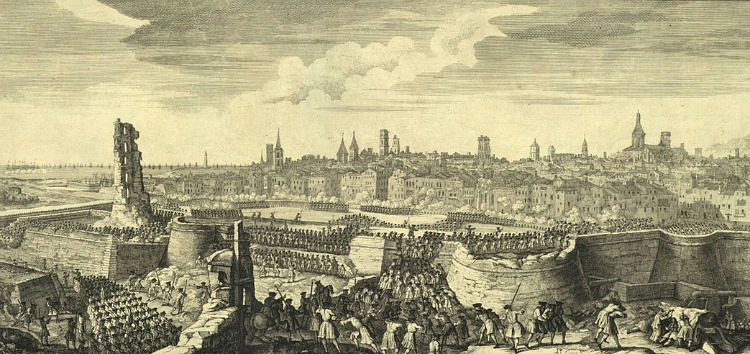26.08.2014 - 13:59
In recent years, the Eleventh of September in Catalonia has been synonymous with large demonstrations in support of Catalan independence called by the Catalan National Assembly, a pro-independence group. But what, really, do we know about this crucial date three hundred years ago, which later became Catalonia’s National Day? Here are a few clues.
What happened on 11 September 1714?
On 11 September 1714, in the final days of the War of the Spanish Succession, the City of Barcelona, which had supported Charles of Austria as successor to the Spanish throne, fell to the troops of Philip of Bourbon, ending a year- and-a-half long siege on the City. The final confrontation began on 12 August at the bastions of Portal Nou and Saint Clara, and the final assault came in the early morning of 11 September (it might have started earlier had it not been for the rain), with heavy fighting in the streets, especially near the Convent of Saint Augustine, between the bastions of Portal Nou and Saint Peter, and around the new Royal Palace near the port. About two o’clock in the afternoon, with a halt in the fighting and Rafael Casanova, mayor of Barcelona and commander in chief, and military commander Antoni de Villarroel both wounded, the Barcelonese resistance decided to open negotiations with the occupying army to demand military capitulations.
What significance did this have?
The fall of the city marked the symbolic (as well as tragic and heroic) endpoint of the War of the Spanish Succession, a war of international scope that erupted in 1701 after the death in Madrid of the childless King Charles II of Castile and Aragon. Although he was succeeded at first by Philip V of the House of Bourbon, with the support of his powerful grandfather Louis XIV of France, shortly thereafter Archduke Charles of Austria claimed the throne with the support of a powerful anti-French alliance formed by England, the Dutch Republic, Portugal, Savoy, and, from 1705, the states that together comprised the composite monarchy of Catalonia and Aragon: Aragon, the Principality of Catalonia, the Kingdom of Valencia, and the Balearic Isles. The military victory of Philip of Anjou also marked the end of the political independence (rights, privileges, liberties, and legal and political institutions) of the Crown of Aragon, suppressed by the so-called Nueva Planta decrees and subsumed by force under the laws of Castile.
Who were the opposing sides?
The siege of Barcelona, which officially began on 25 July 1713, after the departure of the allied British and Imperial troops (in accordance with the agreements of the peace treaties of Utrecht), was a decidedly unequal confrontation: while as many as forty thousand Spanish-French soldiers were periodically assembled outside the city walls (ninety thousand throughout Catalonia), inside the city the resistance was not led by any duly constituted army, but by some six to seven thousand men, including the Miquelets (a paramilitary militia group active mostly within occupied territory, where it conducted guerrilla actions against the invader), Aragonese, Castilian and Valencian refugees who supported the Austrian contender, as well as officers of the former Habsburg regular army who decided to remain at the front (including Antoni de Villarroel). However, an urban and tradesmen militia known as The Regiment of La Coronela, which once numbered 4,700 men, played an especially important role in the defence of the city.
Who formed La Coronela?
La Coronela was divided into six battalions: the battalion of the Holy Trinity, which included, among others, grocers, merchants, tailors, and blacksmiths; the battalion of the Immaculate Conception, which comprised professionals such as notaries public, furriers, cloth dyers, sailors and espadrille crafters; the battalion of Saint Eulalia, consisting largely of royal notaries public, shoemakers, wineskin makers, weavers, and booksellers; the battalion of Saint Matrona, formed by candlestick makers, painters, silversmiths, market gardeners, and stevedores; the battalion of Saint Severus, formed mainly by notaries, boilermakers, butchers and students of medicine, philosophy and theology; and the battalion of the Virgin of Mercy, consisting primarily of carpenters, shopkeepers, cloth merchants, tanners, and tavern owners.
What happened to the leaders of the resistance?
After the capitulation, Bourbon authorities imprisoned the military leaders who had defended Barcelona in support of the Austrian contender to the throne, among them Field Marshal Antoni de Villarroel (until his death, on 22 February 1726) and Valencian general Juan Bautista Basset (also until his death on 15 January 1728). Political leaders such as Rafael Casanova, on the other hand, were not incarcerated, but punished with the confiscation in perpetuity of their property. Some 25,000 to 30,000 Catalan combatants were also exiled to the court of Vienna, where many served the imperial army, among them Antoni Desvalls, who in 1714 had led the defence outside Barcelona.
Why did Barcelona resist for so long?
With the departure in 1713 of the Austrian imperial troops, in compliance with the Treaty of Utrecht, Catalonia was urged to surrender, but the nation’s highest authorities chose to resist for two reasons. Firstly, because of their awareness of Bourbon reprisals against the defeated, as was the case of Valencia after the allied defeat at the Battle of Almansa in 1707, which brought about the sudden loss of privileges and freedoms, as well as a fierce repression that culminated in the burning of many cities. And, secondly, because of the hope that their former allies would eventually come to their aid. For this reason, the Catalan government maintained ambassadors in London and Vienna until the very end, although it was to no avail.
How was the city able to hold out for more than a year?
The siege brought great hardship on the city, especially for the civilian population, but Barcelona was able to hold out for a year and two months thanks to the provisions (such as food and gunpowder) and information that two “islands” supplied during this period: the island of Mallorca to the east, and the Castle of Cardona, on the Principality’s mainland, which Bourbon troops never succeeded in taking.
What was the final toll of the siege?
It is difficult to calculate the death toll of the siege, especially on the Bourbon side, owing to contradicting accounts in historical documents, but it is estimated that, between 25 July 1713 and 11 September 1714, there were about 6,850 casualties on the Catalan side (including civilians killed and wounded) and between ten and fifteen thousand casualties on the Bourbon side. It is also estimated that some 30,068 bombs were dropped on the city during the siege, completely destroying a third of the city and severely damaging another third.
Was Barcelona the last holdout to fall?
No. The last pro-Austrian bastion to fall in Catalonia was the Castle of Cardona, which resisted the Bourbon onslaught until 18 September, when it was forced to capitulate as a condition imposed as part of the surrender of Barcelona, and in order to prevent further loss of civilian lives in the capital. General Josep Moragues accepted the capitulation and retired with his family to his property in the town of Sort. But soon he was required by the Captain General of Barcelona to appear in the capital, where his documentation was seized and he was put under surveillance. Fearing an arrest for conspiracy, he attempted to sail to Mallorca. He was hiding out in the hilly area of Montjuïc preparing to flee, when he was betrayed and taken prisoner in Barcelona on 22 March 1715. He was subsequently tried in a summary proceeding, tortured and ignominiously executed on 27 March 1715, along with captains Jaume Roca and Pau Macip. As a sign of opprobrium, Moragues’s head was placed in an iron cage and hung for public display from the Portal de Mar in Barcelona until March 1727.
The islands of Mallorca and Ibiza, for their part, remained faithful to Charles of Austria until July 1715. Only Menorca, officially under British rule since the Treaty of Utrecht of 1713, was able to escape occupation and annexation to Castile until 1802.




